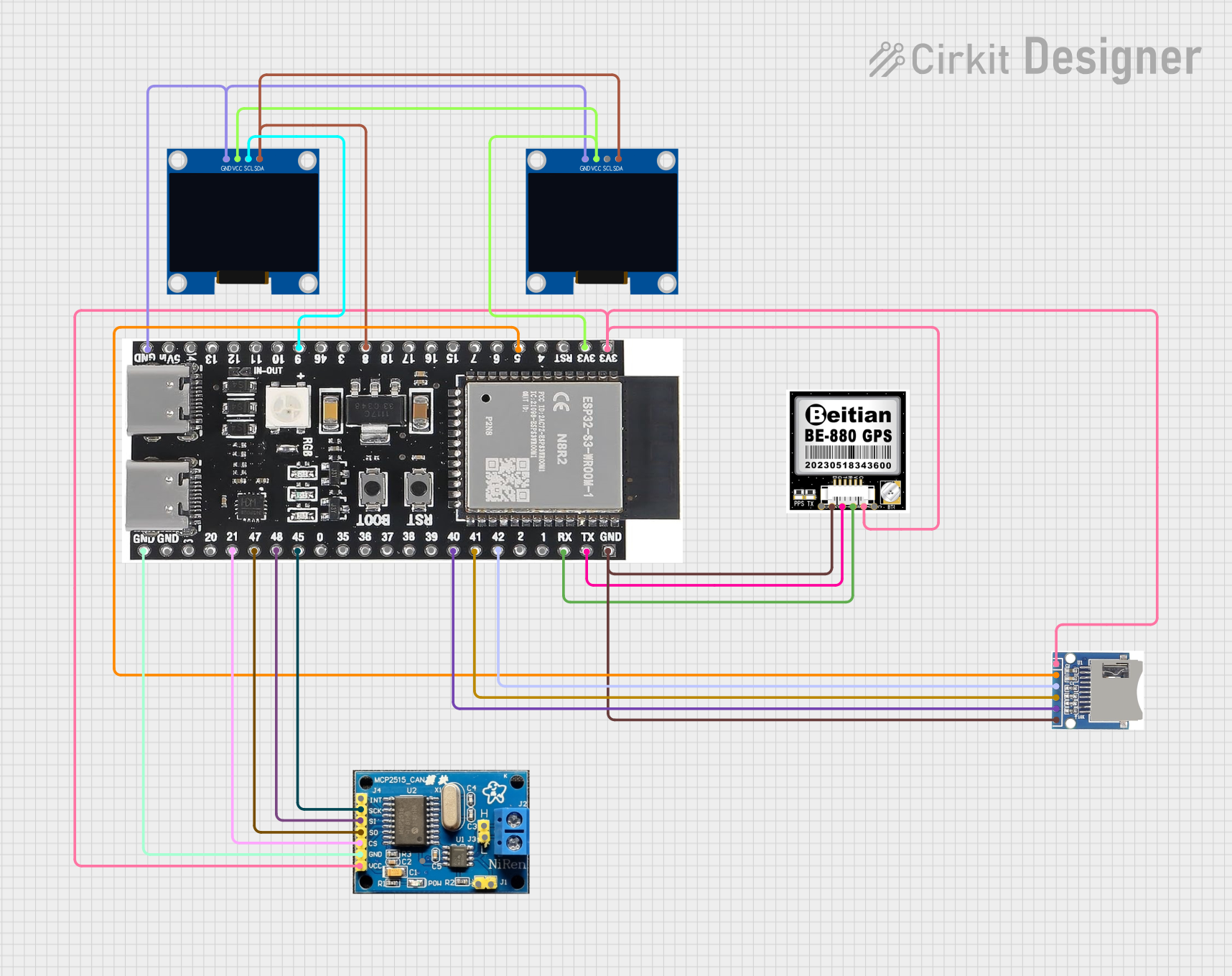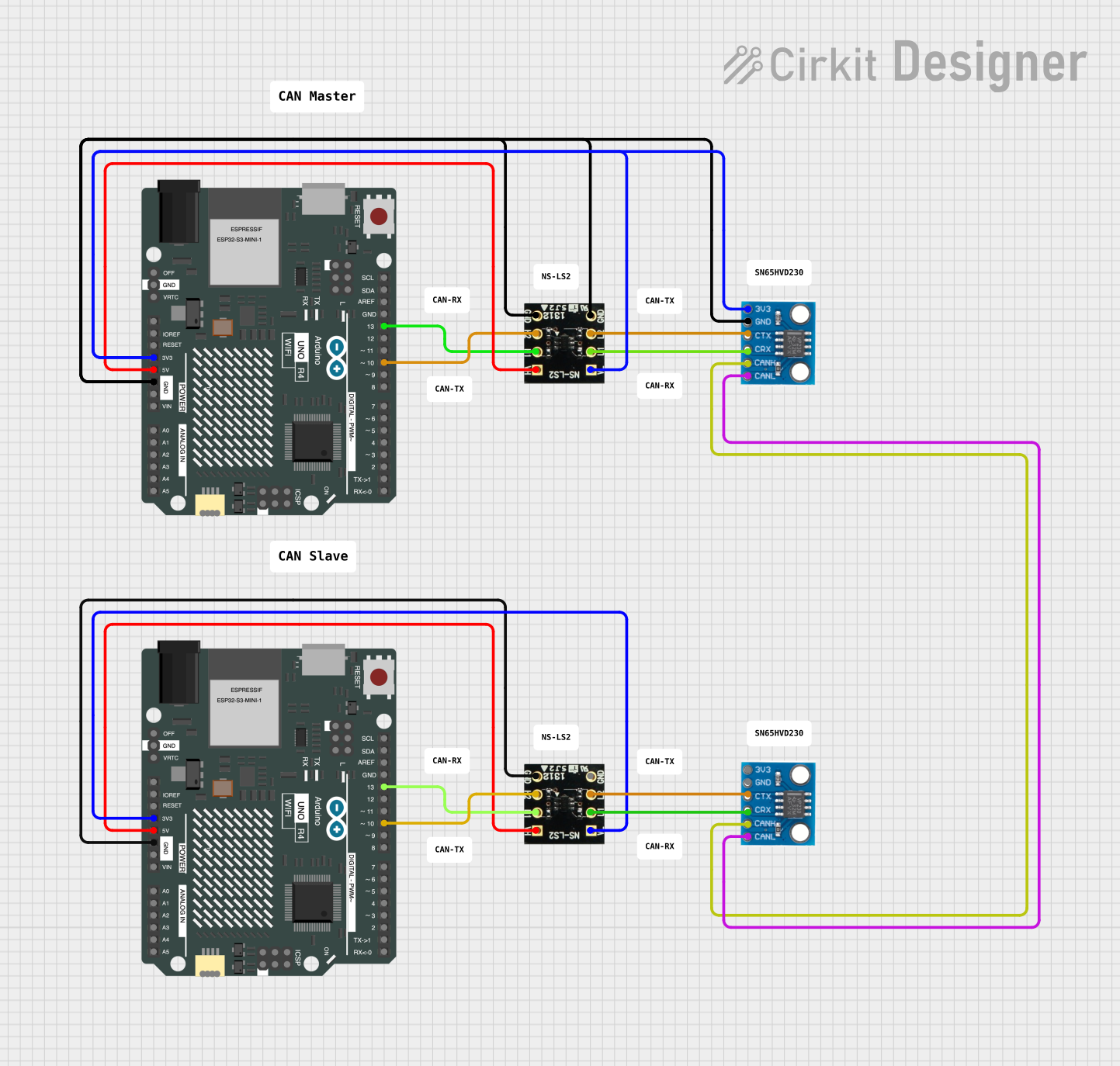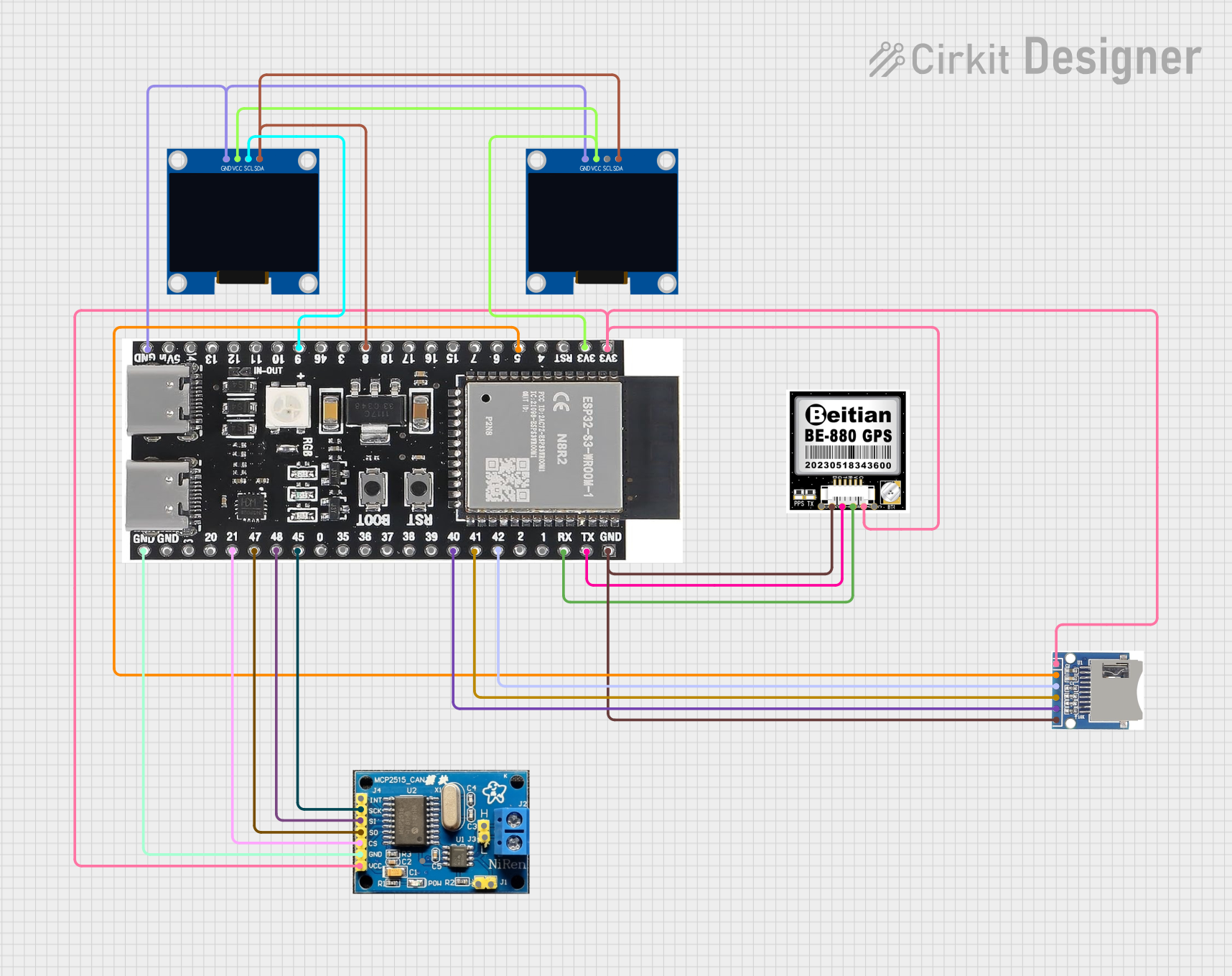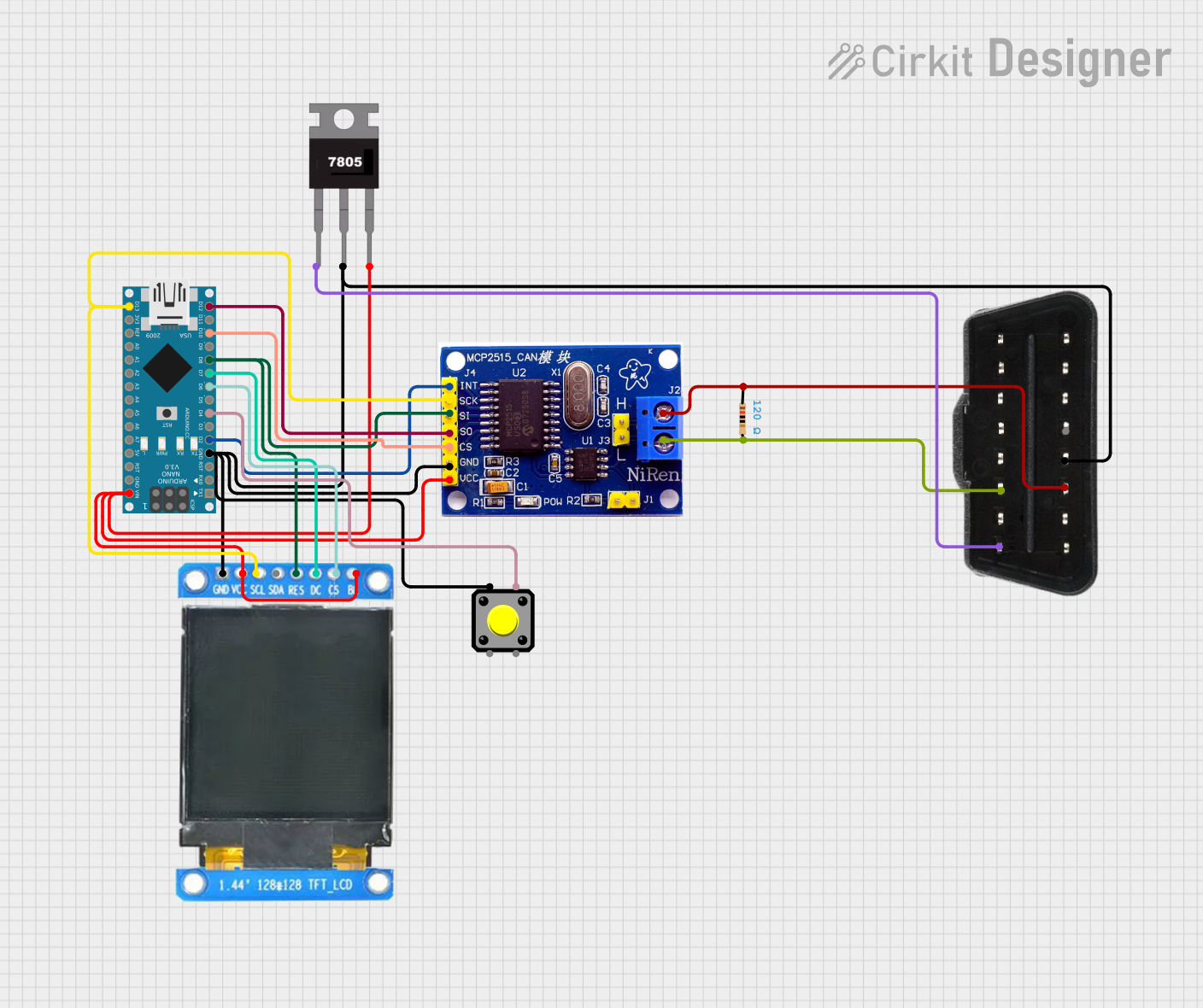
How to Use SN65HVD230 CAN Board: Examples, Pinouts, and Specs

 Design with SN65HVD230 CAN Board in Cirkit Designer
Design with SN65HVD230 CAN Board in Cirkit DesignerIntroduction
The SN65HVD230 CAN Board is a high-performance transceiver module designed to enable communication over the Controller Area Network (CAN) protocol. It acts as an interface between a microcontroller and the CAN bus, facilitating reliable data exchange in automotive, industrial, and embedded systems. This board is particularly valued for its robust error handling, high-speed data transmission, and low power consumption.
Explore Projects Built with SN65HVD230 CAN Board

 Open Project in Cirkit Designer
Open Project in Cirkit Designer
 Open Project in Cirkit Designer
Open Project in Cirkit Designer
 Open Project in Cirkit Designer
Open Project in Cirkit Designer
 Open Project in Cirkit Designer
Open Project in Cirkit DesignerExplore Projects Built with SN65HVD230 CAN Board

 Open Project in Cirkit Designer
Open Project in Cirkit Designer
 Open Project in Cirkit Designer
Open Project in Cirkit Designer
 Open Project in Cirkit Designer
Open Project in Cirkit Designer
 Open Project in Cirkit Designer
Open Project in Cirkit DesignerCommon Applications and Use Cases
- Automotive systems (e.g., engine control units, sensors, and actuators)
- Industrial automation and control systems
- Robotics and embedded systems
- IoT devices requiring CAN communication
- Medical equipment and instrumentation
Technical Specifications
The SN65HVD230 CAN Board is based on the Texas Instruments SN65HVD230 transceiver IC. Below are its key technical details:
Key Technical Details
- Supply Voltage (Vcc): 3.3V
- Bus Voltage Range: -7V to +12V
- Data Rate: Up to 1 Mbps
- Standby Current: < 370 µA
- Operating Temperature Range: -40°C to +85°C
- ESD Protection: ±16 kV (Human Body Model)
- Communication Protocol: CAN 2.0A and CAN 2.0B
- Package Type: DIP module with pin headers for easy integration
Pin Configuration and Descriptions
The SN65HVD230 CAN Board typically has the following pinout:
| Pin Name | Pin Number | Description |
|---|---|---|
| VCC | 1 | Power supply input (3.3V). |
| GND | 2 | Ground connection. |
| TXD | 3 | Transmit data input from the microcontroller. |
| RXD | 4 | Receive data output to the microcontroller. |
| CANH | 5 | High-level CAN bus line. |
| CANL | 6 | Low-level CAN bus line. |
| RS | 7 | Mode selection pin (connect to GND for normal mode, or use a resistor for slope control). |
Usage Instructions
How to Use the SN65HVD230 CAN Board in a Circuit
Power Supply:
- Connect the VCC pin to a 3.3V power source and the GND pin to the ground.
- Ensure the power supply is stable and within the specified voltage range.
Microcontroller Interface:
- Connect the TXD pin of the CAN board to the microcontroller's CAN transmit (TX) pin.
- Connect the RXD pin of the CAN board to the microcontroller's CAN receive (RX) pin.
CAN Bus Connection:
- Connect the CANH and CANL pins to the corresponding lines of the CAN bus.
- Use a 120-ohm termination resistor between CANH and CANL at both ends of the bus for proper signal integrity.
Mode Selection:
- For normal operation, connect the RS pin to GND.
- To enable slope control, connect the RS pin to GND through a resistor (typically 10 kΩ).
Important Considerations and Best Practices
- Ensure the microcontroller supports the CAN protocol and is configured correctly.
- Use twisted-pair cables for the CANH and CANL lines to minimize electromagnetic interference (EMI).
- Verify that the CAN bus is properly terminated with 120-ohm resistors at both ends.
- Avoid exceeding the voltage and current ratings to prevent damage to the board.
- For long-distance communication, ensure proper grounding and shielding of the CAN bus.
Example: Connecting to an Arduino UNO
The SN65HVD230 CAN Board can be used with an Arduino UNO and an MCP2515 CAN controller module. Below is an example code snippet for sending and receiving CAN messages:
#include <SPI.h>
#include <mcp_can.h>
// Define the CS pin for the MCP2515 module
#define CAN_CS_PIN 10
// Initialize the MCP2515 CAN controller
MCP_CAN CAN(CAN_CS_PIN);
void setup() {
Serial.begin(115200); // Initialize serial communication for debugging
while (!Serial);
// Initialize the CAN bus at 500 kbps
if (CAN.begin(MCP_ANY, CAN_500KBPS, MCP_8MHZ) == CAN_OK) {
Serial.println("CAN bus initialized successfully!");
} else {
Serial.println("Error initializing CAN bus.");
while (1);
}
// Set the CAN module to normal mode
CAN.setMode(MCP_NORMAL);
Serial.println("CAN module set to normal mode.");
}
void loop() {
// Example: Sending a CAN message
byte data[8] = {0x01, 0x02, 0x03, 0x04, 0x05, 0x06, 0x07, 0x08};
if (CAN.sendMsgBuf(0x100, 0, 8, data) == CAN_OK) {
Serial.println("Message sent successfully!");
} else {
Serial.println("Error sending message.");
}
delay(1000); // Wait for 1 second before sending the next message
// Example: Receiving a CAN message
if (CAN.checkReceive() == CAN_MSGAVAIL) {
long unsigned int rxId;
byte len;
byte rxBuf[8];
CAN.readMsgBuf(&rxId, &len, rxBuf); // Read the received message
Serial.print("Message received with ID: 0x");
Serial.println(rxId, HEX);
Serial.print("Data: ");
for (int i = 0; i < len; i++) {
Serial.print(rxBuf[i], HEX);
Serial.print(" ");
}
Serial.println();
}
}
Troubleshooting and FAQs
Common Issues and Solutions
No Communication on the CAN Bus:
- Verify that the VCC and GND connections are secure and the power supply is stable.
- Check the TXD and RXD connections between the microcontroller and the CAN board.
- Ensure the CAN bus is properly terminated with 120-ohm resistors.
Data Corruption or Errors:
- Use twisted-pair cables for the CANH and CANL lines to reduce EMI.
- Verify that all devices on the CAN bus are operating at the same baud rate.
- Check for loose or damaged connections on the CAN bus.
High Power Consumption:
- Ensure the RS pin is connected to GND for normal mode or through a resistor for slope control.
- Check for short circuits or incorrect wiring.
FAQs
Q: Can the SN65HVD230 CAN Board operate at 5V?
A: No, the SN65HVD230 is designed to operate at 3.3V. Applying 5V may damage the board.
Q: What is the maximum communication distance for the CAN bus?
A: The maximum distance depends on the baud rate. For example, at 1 Mbps, the maximum distance is approximately 40 meters. Lower baud rates allow for longer distances.
Q: Can I use the SN65HVD230 with a 5V microcontroller?
A: Yes, but you will need a level shifter or voltage divider to safely interface the 3.3V TXD and RXD pins with the 5V microcontroller.
Q: How do I know if the CAN bus is working correctly?
A: Use a CAN analyzer or logic analyzer to monitor the CANH and CANL lines for proper signal activity.